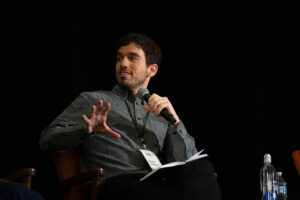April 14, 2024 | Artificial Intelligence, Innovation, ISOJ2024, Journalism Tools
Panel closes the 25th ISOJ with insight into future relationship between journalists and artificial intelligence
Lee este artículo en español abajo
“The human component is always in the middle,” said Sebastián Auyanet Torres, Audience Strategist at NowThis, when referring to artificial intelligence (AI) initiatives during the final panel at the 25th International Symposium on Online Journalism (ISOJ) on April 13.
The panel featured several technology specialists including Andrea L. Guzman, associate professor, Northern Illinois University; Nicolás Grossman, deputy project director, Global Index on Responsible AI & Global Data Barometer, Argentina; and Sil Hamilton, researcher in residence, Hacks/Hackers, Canada.

The conversation, led by assistant professor at the University of Texas’ School of Journalism and Media Josephine Lukito, discussed each panelist’s personal definition of AI and perspectives on how AI has played a role in their career recently.
Grossman started the discussion by defining AI as a “key tool to organize research,” and proposed that the audience think about AI as a “set of technologies” that performs tasks in an autonomous way that was previously thought to only be achievable by humans.
“[AI] are seen as a solution for many of the problems that I face now,” Grossman said. “And also are posing new threats to society or strengthening old problems.”
While Guzman defines AI as a sort of communicative other, many consumers think of the “Hollywood Effect” as she described hearing from over 100 people that they believe AI is anything from the Terminator and aliens to Siri and Alexa.
Hamilton’s definition went back to the roots of the term, coined in 1958 at Dartmouth University with the idea that the brain computes through logical operations, computer science researchers wanted to mimic that brain function with a computer.
Torres, coming from a practice point of view, describes AI as a “compound of technology” that has allowed him to save time and focus on human capabilities as an audience strategist. He offers journalists a new perspective calling AI “AE”, meaning actual experience treating AI as a means to an end not just an end in content production.
Beyond the general concern about the ethics of using AI in the newsroom, the panelists brought up compelling points about the efficiency and safety of bringing AI into journalism.
Hamilton expressed gratitude for AI use in lower-level work like transcribing, summarizing interviews, generating titles and writing captions due to its efficiency. However, he expressed concern stating that the real danger is the belief that AI is advanced enough to complete the higher-level tasks that humans currently run.
“We’ve seen newsrooms be whittled down, more is expected of us,” said Northern Illinois University associate professor Guzman. “Part of this fear about artificial intelligence has nothing to do with AI itself.”

Guzman continued that highlighting questions about AI can’t be disentangled from the economic question. Rather than a fear of the technology, journalists fear AI undermining their agency. She suggests that journalists think of AI in relation to the funding models.
“It’s not AI that’s going to save or ruin journalism,” said Guzman. “It’s people making decisions about what is journalism and what do people value in journalism and what value are we going to put in journalism.”
So, what should journalists do when faced with the increasing abilities of AI?
The consensus from Torres and Hamilton is that AI is still not fool-proof, citing that we still lack the tools and training needed to proficiently detect the use or misuse of AI. “Chat GPT was given one goal and one goal only, that was to mimic human text,” said Hamilton in response to why we need humans to detect false content rather than computers who are blind to tell-tale inconsistencies.
Guzman says that the firehose of misinformation and disinformation is not used as a tactic to change minds, but to further informational bias and confuse the public. She explained that she is teaching her students to work, experiment, and “play” with AI to demystify some of the fears her students may have about its capabilities and limitations.
Torres, perhaps offered the most optimistic approach suggesting that students should empower themselves to do whatever it is they want to do and see how AI can help their career. Journalism students should have dynamic conversations about what AI can do for us rather than to us as journalists.
ISOJ is a global online journalism conference organized by the Knight Center for Journalism in the Americas at the University of Texas at Austin. In 2024, it is celebrating 25 years of bringing together journalists, media executives and scholars to discuss the impact of the digital revolution on journalism.
*Paisley Porter is a second-year Communication and Leadership & Journalism student at UT Austin. She is currently an anchor and a senior Life & Entertainment correspondent for the Texas Student Television News Department.
Panel cierra el 25º ISOJ con una visión de la relación entre periodistas y la IA en el futuro
“El componente humano siempre está en el medio”, dijo Sebastián Auyanet Torres, estratega de audiencias de NowThis, al referirse a iniciativas de inteligencia artificial (IA) durante el último panel del 25 Simposio Internacional de Periodismo Online (ISOJ), el 13 de abril.
En dicho panel participaron varios especialistas en tecnología, entre ellos Andrea L. Guzman, profesora asociada de la Northern Illinois University; Nicolás Grossman, subdirector de proyectos del Global Index on Responsible AI & Global Data Barometer (Argentina); y Sil Hamilton, investigador residente de Hacks/Hackers (Canadá).
La conversación, moderada por la profesora adjunta de la Facultad de Periodismo y Medios de Comunicación de la Universidad de Texas Josephine Lukito, abordó la definición personal de IA de cada panelista y sus perspectivas sobre el papel que la IA ha desempeñado recientemente en su carrera.
Grossman inició el debate definiendo la IA como una “herramienta clave para organizar la investigación”, y propuso al público que pensara en la IA como un “conjunto de tecnologías” que realiza tareas de forma autónoma que antes se creía que sólo podían realizar los humanos.
“[La IA] se ve como una solución para muchos de los problemas a los que nos enfrentamos ahora”, dijo Grossman. “Y también están planteando nuevas amenazas a la sociedad o reforzando viejos problemas”.
Mientras que Guzmán define la IA como una especie de “otro” comunicativo, dijo que muchos consumidores son víctimas del “efecto Hollywood”. Dijo haber escuchado a más de 100 personas que creen que la IA es cualquier cosa, desde Terminator y extraterrestres hasta los asistentes virtuales Siri y Alexa.
La definición de Hamilton se remonta a las raíces del término, acuñado en 1958 en la Universidad de Dartmouth con la idea de que el cerebro computa mediante operaciones lógicas, y los investigadores de informática querían imitar esa función cerebral con un ordenador.
Torres, desde el punto de vista de la práctica, describió la IA como un “compuesto de tecnología” que le ha permitido ahorrar tiempo y centrarse en las capacidades humanas como estratega de audiencias. Torres ofrece a los periodistas una nueva perspectiva llamando a la IA “EA”, es decir, una experiencia real de tratar la IA como un medio para un fin y no sólo como un fin en la producción de contenidos.
Más allá de la preocupación general por la ética del uso de la IA en las redacciones, los panelistas plantearon cuestiones convincentes sobre la eficacia y la seguridad de introducir la IA en el periodismo.
Hamilton expresó gratitud por el uso de la IA en tareas de bajo nivel, como transcribir, resumir entrevistas, generar títulos y escribir subtítulos, debido a su eficiencia. Sin embargo, expresó su preocupación al afirmar que el verdadero peligro es la creencia de que la IA es lo suficientemente avanzada como para realizar tareas de más alto nivel que actualmente llevan a cabo los humanos.
“Hemos visto cómo se reducen las redacciones, se espera más de nosotros”, dijo Guzmán, profesor asociado de la Universidad del Norte de Illinois. “Parte de este miedo a la inteligencia artificial no tiene nada que ver con la IA en sí”.
Guzmán continuó diciendo que las cuestiones destacadas sobre la IA no pueden disociarse de la cuestión económica. Más que un miedo a la tecnología, los periodistas temen que la IA socave sus capacidades. La panelista sugirió a los periodistas que piensen en la IA en relación con los modelos de financiación.
“No es la IA la que va a salvar o arruinar el periodismo”, dijo Guzmán. “Es la gente tomando decisiones sobre qué es el periodismo y qué valora la gente en el periodismo y qué valor vamos a poner en el periodismo”.
Entonces, ¿qué deben hacer los periodistas ante las crecientes capacidades de la IA?
El consenso de Torres y Hamilton es que la IA todavía no es infalible, ya que todavía se carece de las herramientas y la formación necesarias para detectar de forma competente el uso o mal uso de la IA.
“Chat GPT tenía un único objetivo: imitar el texto humano”, dijo Hamilton en respuesta a la pregunta de por qué necesitamos a los humanos para detectar contenidos falsos en lugar de a ordenadores ciegos ante las incoherencias.
Guzmán dijo que la manguera de desinformación e información engañosa no se utiliza como táctica para cambiar mentalidades, sino para fomentar los sesgos informativos y confundir al público. Explicó que está enseñando a sus alumnos a trabajar, experimentar y “jugar” con la IA para desmitificar algunos de los temores que que sus alumnos puedan tener sobre las capacidades y limitaciones de esa tecnología.
Torres ofreció quizá el enfoque más optimista, sugiriendo que los estudiantes deben capacitarse para hacer lo que quieran y ver cómo la IA puede ayudarles en su carrera. Los estudiantes de periodismo, dijo, deberían mantener conversaciones dinámicas sobre lo que la IA puede hacer por nosotros, más que para nosotros como periodistas.
ISOJ es una conferencia mundial de periodismo en línea organizada por el Centro Knight para el Periodismo en las Américas de la Universidad de Texas en Austin. En 2024, celebra 25 años de reunir a periodistas, ejecutivos de medios de comunicación y académicos para debatir el impacto de la revolución digital en el periodismo.
*Paisley Porter es estudiante de segundo año de Comunicación y Liderazgo y Periodismo en UT Austin. Actualmente es presentadora y corresponsal sénior de Life & Entertainment del Texas Student Television News Department.

